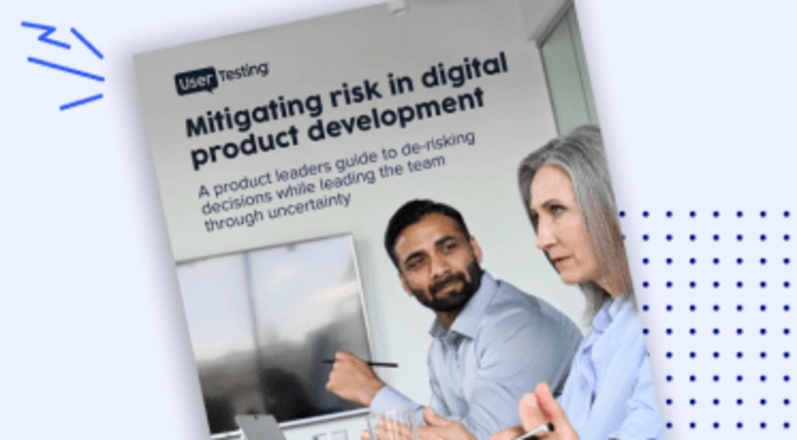
Top 5 digital product mistakes (and how to avoid them)

95% of new products released in any given year will fail. That’s according to the late Harvard Business School professor Clayton Christensen, and it should make product leaders sit up and take note. Digital product mistakes during development and post-launch can lead to catastrophic results.
Consumer digital products have notoriously disappointing metrics across the board, from signup rates to churn. The average mobile app loses 77% of its daily active users within three days of installation and a staggering 90% of daily active users within 30 days.
The competition for users’ attention is high, and today’s consumers are quick to abandon products that don’t delight them or help them solve real challenges.
In this article, we'll explore some of the most frequent mistakes that sabotage new products—and how gathering human insight early and often can ensure your product’s chances of success.
1. Designing solutions before exploring problems
One of the most common mistakes organizations make is pursuing a product idea without first having exploratory conversations with their target market.
Company leaders may have strong convictions about the value of a potential new product. A bullish attitude within the leadership team can generate a lot of momentum for new products—and pressure on the product team to start developing them as quickly as possible.
However, if the product team doesn’t thoroughly vet whether there’s a customer need for the product, they’re taking a double risk. They’re assuming that this particular product is the right solution to a problem, and perhaps more importantly, they’re assuming that this problem exists. This can lead to a dangerous path of sinking valuable resources into a product consumers won’t use, resulting in devastating losses.
Customer-centric organizations approach the early stages of product development differently.
Instead of jumping to solutions and leaning on internal stakeholder opinions, they have discovery conversations with their target users to understand how they’re currently approaching the challenge in question.
- Do they use a competitor’s existing digital product?
- An analog solution like pen and paper?
- What do they like and dislike about their current method?
- How does it make them feel?
- And, crucially, do they even see the challenge as worth solving?
These questions help product teams assess whether a concept is even viable in the market before investing time in designing anything. It may turn out that there’s a significant consumer need for the solution, but it’s much different than they originally imagined. It can also spark unexpected insight into the product’s value proposition and potential features.
Taking the time to start with concept validation research sets product teams off confidently in the right direction, rather than constantly guessing whether their solution is the right one.
Try our concept validation test template
2. Getting user feedback too late in the development process
Many organizations spend months and months designing and building a product in a vacuum and then decide to gather some user feedback immediately before launching it.
While it’s better to get human insight on a product late in development than not at all, uncovering user pain points after a product is nearly complete can lead to the frustrating choice between two options:
- Pushing out the launch date to complete costly and demoralizing rework
- Ignoring critical user feedback to launch on time.
It’s significantly more expensive and time-consuming to fix issues after development is complete than testing at multiple stages—from barebones wireframes to completely functioning prototypes—and adapting to feedback proactively.
By adopting a “test early, test often” philosophy, product teams can reduce their chances of wasting time building the wrong features or designing products with usability problems. Plus, getting frequent insights from prototype testing can inspire new solutions and ideas that wouldn’t have occurred otherwise.
While the best time to test a product idea is before the first wireframe is ever drawn, the second-best time is now.
Try our prototype test template
3. Failure to hook target users
Many consumer digital products attempt to accomplish too many things—trying to be everything to everyone—rather than providing a clear path to the most critical tasks for the target users. This is evident in products that suffer from feature bloat instead of doing an exceptional job with a handful of important features.
Products that don’t offer a direct path from start to habit are likely to get forgotten when there are tons of other products, tasks, and activities competing for a user’s time.
That’s why it’s so important for product teams to test the first-time user experience with their target market (ideally before the product launches).
- How do they interact with the onboarding process?
- Do they hurriedly skip through tooltips that contain necessary instructions?
- Can they understand how to begin using the product without a lot of guidance?
- Do they get a clear sense for how often they’ll return to use the product? (In other words, will they get hooked?)
Recruiting the right users for these tests is key at this stage. Whether your target users are of a certain demographic, interested in a particular topic, or existing loyal customers of your brand, their experience is uniquely important.
Product teams shouldn’t waste time testing their product with internal stakeholders or friends and family who will likely give biased and irrelevant feedback; they should focus on staying customer-centric and understanding how their target users feel about product adoption.
4. Prioritizing business objectives over customer needs
Companies often fall into the trap of making decisions that will (ostensibly) achieve their business objectives in the short term at the expense of helping customers accomplish their own goals within a product.
Driving customers to unrelated offers, displaying ads on top of key workflows, and tucking important tasks away at the bottom of a navigation menu are all examples of ways consumer products get in the user’s way. In this example, customers using a banking app struggled to find the ATM locator among many less frequently needed menu items.
In the end, interfering with the customer’s main objectives will only frustrate them. To prove this point, product leaders need to be prepared to be the strongest advocates for the customer. This includes listening to user feedback frequently, sharing first-person insights from user tests so stakeholders can see and hear customers’ pain points, and being able to demonstrate the ROI of customer-centric decision-making.
5. Not gathering continuous user feedback after launch
After a product is successfully launched, it’s tempting for teams to move along to the next product or feature.
However, there’s always room for continuous improvement. Customer needs are constantly shifting, and the way consumers interact with a product can change from month to month depending on the competitive landscape, new developments in technology, the state of the economy, and many other factors outside of your control.
The most successful product teams continuously listen to customer feedback on their products and use this feedback to prioritize new features. The ongoing process of testing existing products fosters a customer-centric culture and helps the company develop more useful, more needed solutions that keep customers happy and loyal.
Develop products with confidence
By keeping human insight at the heart of product development, product teams can increase their chances of success. Having meaningful conversations with customers and observing how they interact with products at each stage of development is the key to reducing risk in product development.

Reduce risk, manage cost, and stay competitive
Learn how customer insight at every stage of the development process can mitigate risk in product decisions.





